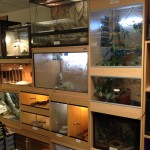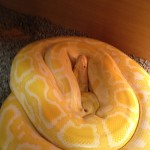Reptile lamps (heat and light, not UVB) are normally incandescent, filament bulbs. Halogen are becoming a bit more popular but are still quite pricey so the traditional heat lamp remains the top seller. They produce light, with heat as a waste product (because they are inefficient at producing light – hence the move to energy efficient lamps in the home). Due to the way they work, heating a thin metal filament in an inert gas to prevent burning, they have a relatively short life span, somewhere in the hundreds of hours. Poor care during transport, couriers throwing boxes around for example, can reduce this life further. However one thing that is almost guaranteed to shorten the life, right down to a few seconds in some cases, is a poorly connected or maintained lamp fitting.
Lamp fittings usually come with the advice something along the lines of “must be fitted by a qualified electrician”. This is often viewed as a covering strategy by the manufacturer. If there is a problem and damage is caused they will always ask for proof that it was fitted correctly. However it is actually essential that fittings are installed by someone who knows what they are doing. In extreme cases, when fitted incorrectly it can lead to electric shock (and potentially death!) or fire. In less extreme cases a poorly connected fitting will result in shortening the lifespan of the bulbs.
Apart from knowing which wire goes to which terminal, a good electrician will also know that the terminal will have a hole for fitting the wire that is bigger than the diamenter of most wires used. This extra space needs to be filled with as much of the wire as possible, so the ends of most will need to be properly trimmed of insulation and doubled over to fill the space (and the trimming of the insulation needs to be done properly or the wire can be weakened). It is normally at this point that problems occur with a lot of fittings. Any looseness, gaps or weakness in the wire or pulling pressure on the terminals will result in a poor connection. What can happen then is electricity will “jump” across any tiny gaps or heat up the connection or wire at points of stress. This can lead to heating and cooling of the connection when the lamp is switched on and off, which can make the situation even worse over time. Fittings can become very hot and if the terminal becomes too loose, can start to spark. Once this happens the voltage generated when the spark occurs is enough to blow any bulb instantly.
We obviously sell lots of bulbs and occasionally one will blow before its time. However when this happens repeatedly it is nearly always down to faulty fittings or pulling out a plug without turning off the switch first (ever noticed the spark when you do this? That’s a very high voltage pushing the electricity across the gap created by pulling the plug away from the terminals and this shortens the life of the bulb.)
So if you find that you are going through more bulbs than you think you should, have a serious think about replacing the the fitting (you may be able to see discolouration, even burning, on the terminals). It will save you money in the long run and possibly even your house! It’s worth checking them from time to time anyway, especially if you have an animal that can get to the cable and put strain on it.
The Angell Pets Team





